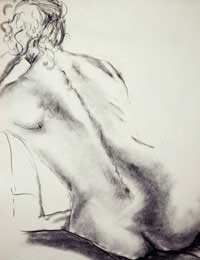Understanding Life Drawing

Life Drawing is the act of drawing the nude 'life-model', a real person posing naked (usually, but not necessarily) for the artist, and underpins the representation of all human figures in drawing and painting, except when the figures are only painted from the shoulders up (as with many portraits).
For many people life drawing is the ultimate in drawing exercises, requiring attention to human anatomy - something that entails very good observation skills.
A Brief History of Life Drawing
The depiction of the human figure in antiquity (Ancient Egypt, Greece and Rome) as well as in early to Medieval Christian iconography, leaves one thinking that either people looked a little odd prior to the Renaissance period of painting, or artists were just not very good.Neither case is actually true. The reason that depictions of the human form prior to the Renaissance were inaccurate are many. Chiefly they come down to custom and perception. Custom has often dictated, for example, that men (and most painters have been men) should not be allowed to paint nude women from life - meaning they had to make do with painting men, and then simply superimpose female features.
The difficulty with perception, on the other hand, dictates that when a person in any society at any time, has come to draw or paint the human figure, certain features are always wrongly depicted. This will be seen when you start to draw from life; heads are often portrayed to large, limbs too short; ears are often omitted entirely, and so on! This occurs as we hold a mental image in our head very different from how people really occur, and in order to draw accurately one has to really look and record facts as they are.
Being able to do this accurately has entailed centuries of research. Quite simply, it follows that as drawing the human figure accurately is not essential to survival, it is a skill that has taken time for humanity to acquire.
Aside from improvements in the accuracy of Life Drawing, the depiction of nudity in painting has been at the centre of changing attitudes towards sex and the human form. For millennia naked women have been portrayed in paintings under the premise that their nudity was central to the relaying of, for example, a Greek Myth. In the majority of cases one might wonder why nudity was necessary at all.
In the 19th Century Courbet put paid to such beating around the bush, by portraying the female nude very directly, and without and wider context than that he wanted to portray, graphically, the female form. So it is worth considering, if you at first feel uncomfortable painting a nude stranger in a drawing class, that life drawing is central to shaping attitudes about nudity across society, and for all of history.
Life Drawing made Easier
The only way to develop life-drawing skills is through practice and observation. By making mistakes and being self critical we can pick up on how we are mis-perceiving the human form and make gradual corrections.If ears are left out, or hands are drawn as if 'behind backs' or 'in pockets', to take two common examples, it will be clear that you have avoided them because:
- You don't generally look at ears and hands, or take note of them.
- Or: You find ears and hands difficult to draw, so you try and avoid them, hoping nobody notices!


Re: Contextualising Your Work
Dear Mr Watson, I have been working relentlessly for 40 years through Art, writing, performance based expressions in theatre, dance,…
Re: How to Sell My Paintings and Drawings?
Hi , I would like say about my cousin that he live in Afghanistan and he is fabulous in art painting and doing job…
Re: How to Sell My Paintings and Drawings?
Amy - Your Question:Hi I have just left school and I love to draw I do pencil work and I would love to sell my…
Re: How to Sell My Paintings and Drawings?
Hi I have just left school and I love to draw I do pencil work and I would love to sell my drawing but I don't no how…
Re: How to Sell My Paintings and Drawings?
Hi, I have 3 drawings the information as follows: 1- Salvador Dali (Spanish Draftsman). Is 24x19 cm. 2- Pablo…
Re: Freeing Yourself Up
I love drawing so much and I will like to be one of the best artist in the world
Re: How to Sell My Paintings and Drawings?
anna-81 - Your Question:Hi, I need help how can I sale my paintings and drawings and I want to know if my work is…
Re: How to Sell My Paintings and Drawings?
Hi, i need help how can i sale my paintings and drawings and i want to know if my work is really good or not. I'm…
Re: How to Sell My Paintings and Drawings?
i want to sell my drawing give me the idea.
Re: How to Sell My Paintings and Drawings?
I am 15 years old and i would like to sell my pencil drawing